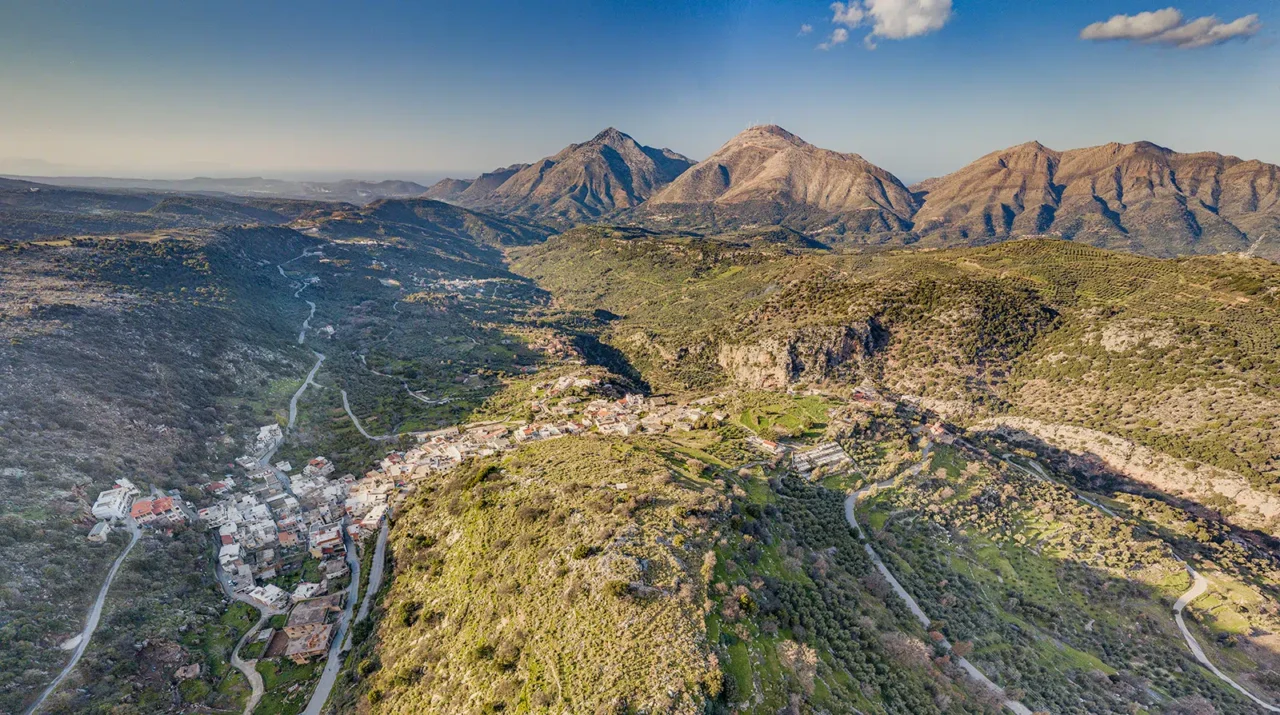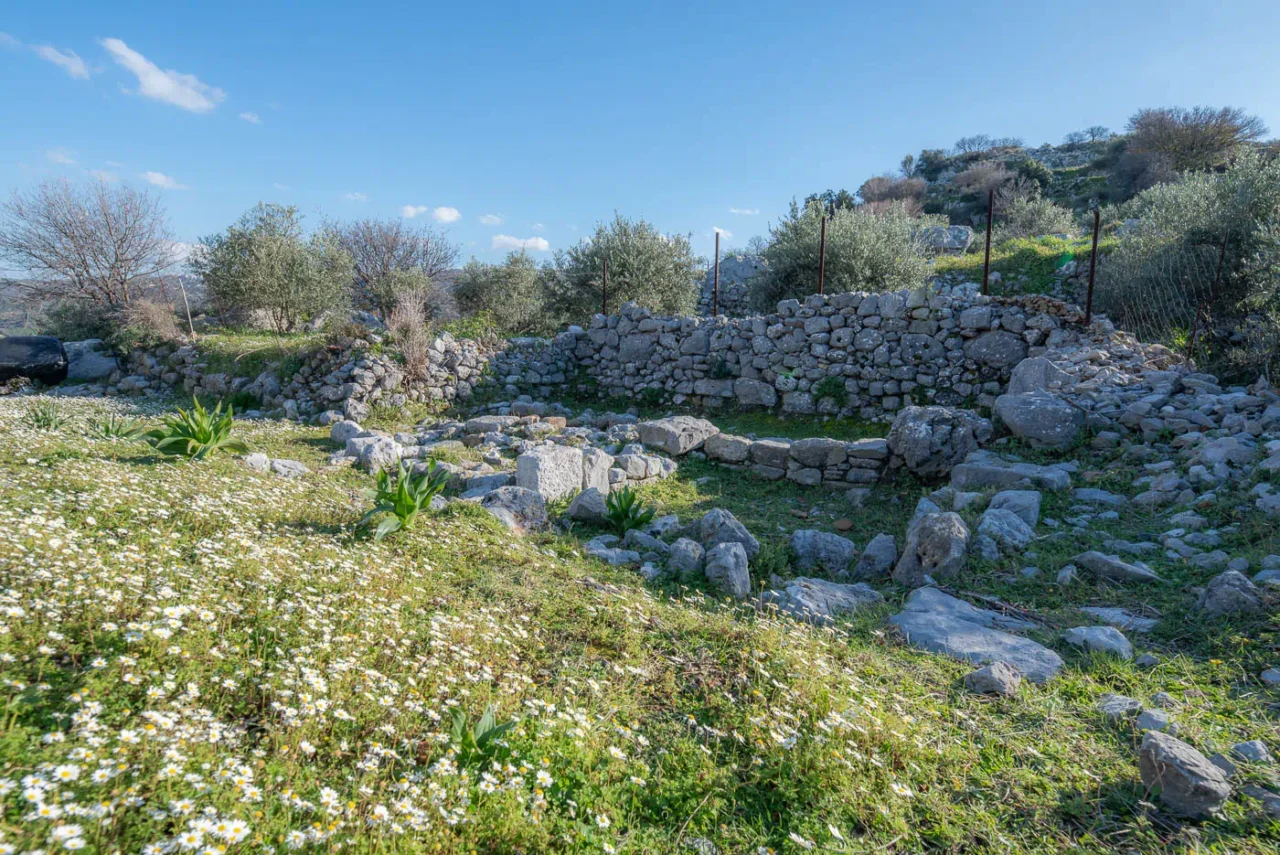

A prominent city of ancient Crete
Oaxos, also known as Axos, was a significant city in ancient Crete, located in the Mylopotamos region. It was known for its strategic location, its association with the Idaean Cave, and its connections with other important cities of the time. The city’s history spans several periods, from the Minoan era to the Venetian period, with each era leaving its own mark on the city’s development and legacy.
Minoan and Early Periods
Evidence suggests that Oaxos existed as early as the Minoan period, with archaeological findings revealing the presence of post-Minoan settlements and artifacts. (Tzigounaki 2019) The city’s strategic location on a natural pass between the Amari valley and Mylopotamos likely contributed to its early development and importance. (Tzigounaki 2019)
Geometric and Archaic Periods
Oaxos continued to thrive in the Geometric and Archaic periods, with archaeological findings revealing the presence of cyclopean walls, terracotta female idols in the Daedalic style, and bronze molds dating back to the 7th century BC. (Tzigounaki 2019) These findings suggest that the city was a center of artistic production and religious activity during this time. On one bronze mold, there is an image of a geometric tripod. The tripod is framed by two lions, and over the boiler of the tripod, there is an image of a divinity with long hair, armored with a sword and shield. (Vasilakis 2019)
Classical and Hellenistic Periods
Oaxos maintained its prominence in the Classical and Hellenistic periods, with evidence suggesting that the city was involved in interstate contracts with foreign powers, including the city of Miletos in the 3rd century BC. (Tzigounaki 2019) This indicates that Oaxos was an active participant in the wider political and economic landscape of the time.
From Herodotus’ time to the present day, the name of the village is found in written texts, inscriptions, and coins in various forms, all of which, however, are based on “Axos,” the name that the village retains today.
The form “Oaxos” is first provided by Herodotus from the 5th century BC: “There is Oaxos of Crete, where Etearchos became king” and below: “for Themiston, the Theran merchant, was in Oaxos.” The same form is preserved later, in chronological order, by Xenion, Herodianos, and the lexicographer Stephanos Byzantios. The latter, who also preserves the form Axos, notes: “Oaxos, a city of Crete, not far from Eleutherna, according to Xenion, from Oaxos, son of Akakalida, daughter of Minos.” The same form is also found in various inscriptions, such as in Athens, Delphi, Delos, Miletos, and Tegea.
The form “Oaxis” is given by Apollonius of Rhodes and the Latin authors Servius, in a commentary on Virgil’s Bucolica where he refers to Varro and notes “Oaxes, (retae, a quo civitas Oaxia)” (Oaxes, a river of Crete, from which the city of Oaxia), and Vilius Sequester.
The form “Oaxios” is found in Hierocles, while the forms Favyos and Fayion are found from the beginning of the 3rd century BC a) in inscriptions, such as in Delphi (along with the form Oaxos) in Axos’ response to a letter from the Aetolians, in early 3rd century BC Gortyn (Crete) of the same period and of Axos itself and b) in coins of the city.
Finally, the form “Axos” appears epigraphically in Delphi, Miletos, and Karthaia, a city of Kea (Tzia), in the 3rd century BC in Orchomenos, early 1st century BC, in Gortyn of Crete, in a treaty with Eumenes, in the 1st century BC, and in coins of Axos itself, of the 1st century BC, for the first time.
A recession in the coinage of Axos
Between 270 and 220 BC, there was a recession in the coinage of Axos, as in other Cretan cities. (Tzigounaki 2019) The recession in the coinage of Axos may be attributed to several factors, including the city’s limited production capacity, the low quality of its coins, and the narrow geographical bounds of its circulation. (Tzigounaki 2019) Additionally, the city’s introverted participation in economic transactions may have also contributed to the recession. (Tzigounaki 2019)
Roman and Venetian Periods
Oaxos continued to exist until the Byzantine period, with archaeological findings revealing the presence of nine Byzantine churches in the area. (Tzigounaki 2019) The city was eventually destroyed by the Venetians, and its inhabitants moved to the hinterland and established the village of Anogeia. (Tzigounaki 2019).
The Venetian traveler Franciscas Barotti was the first to visit Axos in 1557 AD and published one of the approximately 60 inscriptions that survive today. In more recent times, Pashley (1834), Spratt (1851-53), and Thenon (1857) were the first to discover its ancient ruins, providing information about it and sparking the interest of all the others who later studied it, such as Hassoulier (1879), Halbett, Desaqetis (1899, 1900), Tarammelli, and others.
Coins from the Roman period
Despite the recession in the coinage of Axos during the Hellenistic period, the city continued to produce coins in the Roman period. These coins often featured the head of Apollo or Artemis, along with a tripod. Some coins also had the inscription “FAXION” or “CAXION.” (Vasilakis 2019)
Connections with Other Cities
Oaxos had connections with several other important cities in ancient Crete, including Knossos, Lyttos, Eleutherna, and Hierapytna. These connections were based on political alliances, economic relationships, and religious ties.
- Knossos: Oaxos was allied with Knossos in the civil war of 220 BC against a federation of other Cretan cities. (Vasilakis 2019) This alliance highlights the political ties between the two cities and their cooperation in times of conflict.
- Eleutherna: Oaxos and Eleutherna were both involved in interstate contracts with the city of Miletos. (Tzigounaki 2019) This suggests that the two cities had economic relationships with Miletos and potentially with each other.
- Lyttos: Oaxos and Lyttos were both Doric cities, and they shared a common cultural heritage. (Vasilakis 2019) This cultural connection may have led to political and economic ties between the two cities.
Religious Significance
Oaxos was associated with the Idaean Cave, an important place of worship in ancient Crete. The city’s location near the cave likely contributed to its religious significance and its role as a center of religious activity. (Tzigounaki 2019)
The god of the Idaean Cave
The Idaean Cave was dedicated to the cult of Diktaian or Cretan-born Zeus. (Vasilakis 2019) According to mythology, Zeus was the son of Rhea and Cronus, and he was born at Diktaion Andron but was transferred to Idaion Andron. (Vasilakis 2019) The cave was an important pilgrimage site for the ancient Cretans, and it played a significant role in their religious beliefs and practices.
Numismatic Evidence
The coinage of Oaxos is characterized by its small volume of production, low quality of execution, limited iconography, and narrow geographical bounds of circulation. However, it covers the whole gamut of denominations and seems to copy the issues of Eleutherna. (Tzigounaki 2019) The coins of Oaxos feature images of Apollo, Artemis, and Zeus, reflecting the city’s religious beliefs and its connections with other cities. (Tzigounaki 2019)
Symbols on the coins of Oaxos
Some of the symbols featured on the coins of Oaxos include:
- Apollo with a garland: This symbolizes the city’s worship of Apollo, who was considered the god of music, poetry, and light.
- Artemis: This symbolizes the city’s worship of Artemis, who was considered the goddess of the hunt, wild animals, and childbirth.
- Tripod: This symbolizes the city’s connection to the Idaean Cave, where tripods were often used as votive offerings.
Conclusion
Oaxos was a significant city in ancient Crete, with a rich history and important connections with other cities of the time. Its strategic location, its association with the Idaean Cave, and its participation in political alliances and economic relationships contributed to its prominence and its lasting legacy. The archaeological findings and numismatic evidence from Oaxos provide valuable insights into the city’s development, its religious beliefs, and its connections with the wider world.
Site: Key Points
- Construction Period: Axos was inhabited from the Neolithic period (7000-3000 BC) to Venetian period
- Location: Axos is located on the island of Crete, in the Mylopotamos region, on the northern slopes of Mount Idi (Psiloritis).
- Dimensions: The ancient city had a considerable perimeter, it’s noted that Ptolemy Philopator built a wall around the city that extended for 80 stadia*
*Stadia: A “stadion” (plural “stadia”) was a Greek unit of length, roughly equivalent to 185 meters (or about 607 feet). It was based on the length of a typical athletic stadium in ancient Greece. So 80 Stadia Wall: When Ptolemy Philopator built a wall around Axos that extended for 80 stadia, this means the wall had a total length of approximately 14.8 kilometers (or about 9.2 miles). - Historical Significance: Axos was one of the most important cities in ancient Crete. It had its own currency and was a member of the Cretan “Koinon” (a kind of confederation of Cretan cities). The city was known for its strong walls and acropolis. It was also the birthplace of the philosopher Myson, one of the Seven Sages of Greece. Axos had its own laws and political system, and it was an active participant in the Cretan “Koinon.” The city was also known for its sanctuary of the Diktaean Zeus.
- Current Status: Today, only a few ruins of the ancient city remain. Some of the most important artifacts found at the site, such as statues of Marcus Aurelius and Trajan, are housed in the Heraklion Archaeological Museum.
References
- Baldwin Bowsky, M. 2001. A temple of Hermes at Sybritos: on the road from Gortyn to the Diktynnaion (Crete). Annuario della Scuola Archeologica Atene e delle Missioni Italiane in Oriente 79: 263-276.
- Chaniotis, A. 1996. Die Verträge zwischen kretischen Poleis in der hellenistischen Zeit. Stuttgart: Franz Steiner Verlag.
- Perlman, P. 2004. Crete, in M.H. Hansen and T.H. Nielsen (eds) An inventory of Archaic and Classical Poleis: 1144-1195. Oxford: Oxford University Press.
- Stampolidis, N. 2004. Eleutherna. The Place, in N. Stampolidis (ed.) Eleutherna: City – Acropolis – Necropolis: 18-21. Athens: Hellenic Ministry of Culture – University of Crete – Museum of Cycladic Art.
- Stefanakis, M. I. 2019. The Testimony of Coins, in N. Chr. Stampolidis, D. I. Tsangari, and M. Giannopoulou (eds.) Cretan Cities: The Testimony of Coins: 59-67. Athens: Alpha Bank.
- Tzigounaki, A. 2019. The Cities of Central-west Crete in Historical Times: Rithymna, Lappa, Eleutherna, Sybritos, Axos or Oaxos, in N. Chr. Stampolidis, D. I. Tsangari, and M. Giannopoulou (eds.) Cretan Cities: The Testimony of Coins: 59-68. Athens: Alpha Bank.
- Vasilakis, A. T. 2019. The Ancient Cities of Crete. Iraklion, Crete: Mystis.
Access
The site is next to the modern settlement of Axos.


There are no comments yet.